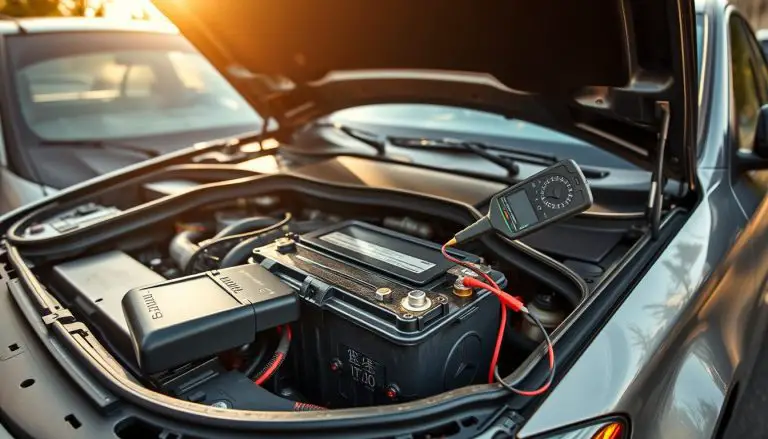When your Mercedes vehicle goes into limp mode, it’s a sign that something is amiss. This safety feature is designed to prevent further damage by limiting the vehicle’s performance. Understanding Mercedes limp mode is crucial for diagnosing and resolving the underlying issue.
Diagnosing and fixing the problem promptly is essential to get your vehicle back to its optimal state. This article will guide you through the process of identifying the cause of Mercedes limp mode and provide a step-by-step repair guide.
Key Takeaways
- Understanding the causes of Mercedes limp mode
- Step-by-step guide to diagnose the issue
- Repair strategies for Mercedes limp mode
- Importance of prompt diagnosis and repair
- Tips for preventing future occurrences
Understanding Mercedes Limp Mode: What Causes It and How to Fix It
Limp mode is a protective mechanism in Mercedes cars that helps prevent engine damage by limiting performance. When your Mercedes enters limp mode, it signifies that the vehicle’s onboard computer has detected a problem that could potentially harm the engine or other critical components.
What Is Limp Mode and Why Does It Happen?
Limp mode, also known as “limp home mode,” is a safety feature designed to allow your vehicle to continue operating, albeit with reduced performance, when a fault is detected. This mode can be triggered by a variety of issues, including engine sensor failures, transmission problems, or fuel system malfunctions. The primary goal of limp mode is to prevent further damage to the engine or other parts of the vehicle.
Some common causes of limp mode in Mercedes vehicles include faulty throttle position sensors, malfunctioning mass airflow sensors, and issues with the transmission. Understanding these causes is crucial for diagnosing and fixing the problem.
How Limp Mode Protects Your Mercedes Engine
When your Mercedes enters limp mode, the vehicle’s computer limits the engine’s performance to prevent potential damage. This can manifest as reduced power output, limited throttle response, or even a cap on the vehicle’s top speed. By restricting engine performance, limp mode helps to prevent further damage to the engine or other components.
For instance, if a faulty sensor is causing the engine to run too rich (more fuel than air), limp mode can help by reducing engine power and preventing potential damage from excessive fuel consumption or engine knocking.
“The implementation of limp mode in modern vehicles like Mercedes is a testament to the advancements in automotive technology, prioritizing both performance and safety.” – Automotive Expert
A detailed look at how limp mode operates and its benefits can be seen in the following table:
| Limp Mode Feature | Description | Benefit |
|---|---|---|
| Reduced Engine Power | Limits the engine’s power output | Prevents excessive strain on the engine |
| Limited Throttle Response | Restricts how far the throttle can open | Reduces the risk of engine damage from sudden acceleration |
| Capped Top Speed | Limits the vehicle’s maximum speed | Prevents high-speed damage to the engine or transmission |
By understanding how limp mode works and what triggers it, Mercedes owners can take appropriate actions to diagnose and fix issues, ensuring their vehicle remains in good condition.
Common Symptoms of Mercedes Limp Mode
Identifying the common symptoms of Mercedes limp mode is the first step towards diagnosing and fixing the problem. When your Mercedes enters limp mode, it exhibits specific behaviors and warning signs that indicate something is amiss. Recognizing these symptoms early can help prevent further damage to your vehicle.
Performance-Related Symptoms
One of the primary indicators of limp mode is a noticeable decline in your Mercedes’ performance. This can manifest in several ways, including:
- Reduced engine power
- Sluggish acceleration
- Difficulty maintaining speed on inclines
- Transmission issues, such as hesitation or slipping between gears
Table: Common Performance-Related Symptoms
| Symptom | Description | Possible Cause |
|---|---|---|
| Reduced Engine Power | Engine does not produce its usual power | Faulty throttle position sensor or fuel system issues |
| Sluggish Acceleration | Vehicle takes longer than usual to accelerate | Clogged fuel filter or transmission problems |
| Difficulty Maintaining Speed | Vehicle struggles to maintain speed, especially uphill | Engine or transmission issues, possibly due to sensor failures |

Dashboard Warning Signs and Messages
In addition to performance issues, your Mercedes’ dashboard will often display warning signs or messages when it enters limp mode. These can include:
- Check Engine Light (CEL) illuminated
- Specific error messages related to engine or transmission issues
- Warning lights for temperature, oil, or other critical systems
It’s crucial to take these warnings seriously and investigate the cause rather than simply resetting the lights. Understanding these symptoms can help you diagnose the issue more effectively.
Primary Causes of Limp Mode in Mercedes Vehicles
Limp mode is a protective mechanism in Mercedes vehicles that reduces engine power to prevent damage, and diagnosing its cause is essential for repair. When a Mercedes enters limp mode, it’s a sign that the vehicle’s onboard computer has detected a potential issue that could cause damage if not addressed.
Transmission Issues
Transmission problems are a common cause of limp mode in Mercedes vehicles. Issues such as low transmission fluid levels, faulty solenoids, or worn-out clutch packs can trigger the onboard computer to activate limp mode.
- Low transmission fluid levels
- Faulty transmission solenoids
- Worn-out clutch packs
Engine Sensor Failures
Engine sensor failures can also cause limp mode. Faulty sensors such as the mass airflow sensor, crankshaft position sensor, or coolant temperature sensor can send incorrect signals to the onboard computer, leading to limp mode.
Common engine sensors that can cause limp mode:
- Mass airflow sensor
- Crankshaft position sensor
- Coolant temperature sensor
Fuel System Problems
Fuel system issues, including faulty fuel injectors, a clogged fuel filter, or a malfunctioning fuel pump, can trigger limp mode. These problems can cause the engine to run inefficiently, leading to reduced performance.
Electrical System Faults
Electrical system faults, such as wiring issues, faulty relays, or a malfunctioning ECU, can also cause limp mode. These faults can disrupt communication between the onboard computer and other components, leading to reduced engine performance.
| Cause | Description | Symptoms |
|---|---|---|
| Transmission Issues | Low transmission fluid, faulty solenoids, worn clutch packs | Slipping gears, delayed shifting |
| Engine Sensor Failures | Faulty mass airflow, crankshaft position, or coolant temperature sensors | Poor engine performance, stalling |
| Fuel System Problems | Faulty fuel injectors, clogged fuel filter, malfunctioning fuel pump | Poor fuel efficiency, engine hesitation |
| Electrical System Faults | Wiring issues, faulty relays, malfunctioning ECU | Intermittent engine performance, dashboard warning lights |
Diagnosing Mercedes Limp Mode at Home
Mercedes owners can diagnose limp mode without visiting a mechanic by using a few simple methods. Diagnosing the issue at home can save time and money, and it’s a great way to understand your vehicle’s condition better.
Using OBD-II Scanners for Error Codes
An OBD-II scanner is an essential tool for diagnosing Mercedes limp mode. It connects to your vehicle’s onboard diagnostics system and retrieves error codes that indicate the problem. To use an OBD-II scanner:
- Locate the OBD-II port in your Mercedes, usually found under the steering column.
- Plug in the OBD-II scanner and turn on the ignition.
- Follow the scanner’s instructions to read the error codes.
These codes will provide valuable information about the cause of the limp mode.
Interpreting Common Mercedes Fault Codes
Once you have the error codes, you need to interpret them. Mercedes fault codes can be specific to the model and year of your vehicle. Common codes related to limp mode include:
| Code | Description |
|---|---|
| P0120 | Throttle/Pedal Position Sensor/Switch Circuit Malfunction |
| P0700 | Transmission Control System Malfunction |
| P0300 | Random/Multiple Cylinder Misfire Detected |
Refer to your Mercedes owner’s manual or a repair manual for a comprehensive list of codes and their meanings.
Visual Inspection Checklist
A visual inspection can reveal potential causes of limp mode. Check the following:
- Fluid levels: Ensure engine oil, coolant, and transmission fluid are at the recommended levels.
- Wiring: Look for signs of wear, damage, or corrosion on wiring and connections.
- Sensors: Inspect sensors for damage or loose connections.
A thorough visual inspection can help identify issues that might not trigger an error code.
“A simple visual inspection can often reveal the root cause of the problem, saving you time and money on unnecessary repairs.”
Testing Sensors and Connections
Faulty sensors or poor connections can trigger limp mode. To test sensors and connections:
- Use a multimeter to check voltage and resistance according to the manufacturer’s specifications.
- Inspect connections for corrosion or damage and clean or replace as necessary.
Refer to a Mercedes repair manual for specific testing procedures and values.
By following these steps, you can diagnose and potentially fix the limp mode issue in your Mercedes at home.
Step-by-Step Fixes for Common Limp Mode Issues
Fixing Mercedes limp mode requires a systematic approach to diagnose and repair the underlying causes. Limp mode is a protective mechanism that limits your vehicle’s performance to prevent damage when a fault is detected. By understanding the common causes and applying the appropriate fixes, you can get your Mercedes back to normal operation.
Resetting the ECU
One of the simplest ways to resolve limp mode is by resetting the Engine Control Unit (ECU). This can sometimes clear minor glitches that trigger limp mode. To reset the ECU, follow these steps:
- Turn off the engine and remove the key from the ignition.
- Disconnect the negative battery cable and wait for at least 15 minutes to ensure the ECU is fully reset.
- Reconnect the battery cable and start the engine.
Note: Resetting the ECU will not fix underlying problems but can help determine if the issue is software-related.
Addressing Transmission Fluid Problems
Low or dirty transmission fluid can trigger limp mode. Checking and maintaining the correct transmission fluid level is crucial. Here’s how to do it:
- Locate the transmission fluid dipstick under the hood.
- Check the fluid level against the dipstick markings.
- If the level is low, add the recommended transmission fluid.
| Transmission Fluid Condition | Recommended Action |
|---|---|
| Low Fluid Level | Add recommended transmission fluid |
| Dirty or Contaminated Fluid | Change transmission fluid and filter |
Replacing Faulty Sensors
Faulty sensors can send incorrect signals to the ECU, triggering limp mode. Common sensors that might cause this include the Mass Airflow Sensor (MAF) and the Crankshaft Position Sensor (CKP). Replacing a faulty sensor involves:
- Identifying the faulty sensor using diagnostic tools.
- Purchasing a replacement sensor from a reputable supplier.
- Following the manufacturer’s instructions to replace the sensor.
Fixing Wiring and Connection Issues
Wiring and connection problems can also cause limp mode. Inspecting the wiring harnesses and connections for signs of wear, corrosion, or damage is essential. To fix wiring issues:
- Inspect wiring harnesses for visible damage.
- Clean or replace corroded connectors.
- Repair or replace damaged wiring.
Safety Precautions When Working on Your Mercedes
When working on your vehicle, safety is paramount. Always follow these precautions:
- Wear protective gear, including gloves and safety glasses.
- Ensure the vehicle is on a level surface and apply the parking brake.
- Disconnect the battery before starting work on electrical systems.
By following these step-by-step fixes, you can address common issues that cause limp mode in your Mercedes. If the problem persists, it may be necessary to consult a professional mechanic for further diagnosis and repair.
When to Seek Professional Mercedes Service
While DIY repairs can be cost-effective, there are situations where seeking professional Mercedes service is the best course of action. Complex issues, model-specific problems, and the cost implications of DIY versus professional repairs are key factors to consider.
Complex Issues Requiring Specialized Tools
Some Mercedes limp mode issues involve complex problems that require specialized diagnostic tools and expertise. For instance, advanced engine or transmission issues may necessitate the use of proprietary Mercedes-Benz diagnostic equipment.
Common complex issues include:
- Advanced engine management system faults
- Transmission control module problems
- Faults in the electronic stability control system
These issues often require the attention of a professional mechanic with access to the necessary tools and training.
Model-Specific Considerations
Different Mercedes models have unique characteristics that can affect the diagnosis and repair of limp mode issues. For example, the C-Class, E-Class, and S-Class models may have distinct engine, transmission, or electronic system configurations.
| Model | Common Limp Mode Causes | Recommended Repair Approach |
|---|---|---|
| C-Class | Transmission issues, faulty sensors | Professional diagnosis and repair |
| E-Class | Engine management system faults, wiring issues | Use of advanced diagnostic tools |
| S-Class | Complex electronic system faults, software issues | Authorized Mercedes-Benz service center |
Cost Comparison: DIY vs. Professional Repair
When deciding between DIY repairs and professional service, it’s essential to consider the cost implications. While DIY repairs may seem cost-effective initially, incorrect diagnoses or incomplete repairs can lead to higher costs in the long run.
A cost comparison between DIY and professional repairs is as follows:
| Repair Type | Initial Cost | Potential Additional Costs | Total Estimated Cost |
|---|---|---|---|
| DIY Repair | $100-$500 | $500-$1,500 (if incorrect or incomplete) | $600-$2,000 |
| Professional Repair | $500-$2,000 | $0-$500 (depending on warranty) | $500-$2,500 |
In conclusion, while DIY repairs can be a viable option for some Mercedes limp mode issues, complex problems, model-specific considerations, and cost implications often make seeking professional Mercedes service the best choice.
Conclusion
Understanding and addressing Mercedes limp mode is crucial for maintaining your vehicle’s performance and longevity. This condition, triggered by the vehicle’s onboard computer to prevent damage, can be caused by various factors including transmission issues, engine sensor failures, and electrical system faults.
Diagnosing limp mode involves using OBD-II scanners to retrieve error codes, interpreting these codes, and performing visual inspections and sensor tests. Common fixes include resetting the ECU, addressing transmission fluid problems, replacing faulty sensors, and repairing wiring issues.
While some issues can be resolved at home, complex problems require professional attention, especially for models like the C-Class, E-Class, and S-Class. Understanding the cost comparison between DIY repairs and professional service is also essential.
In summary, Mercedes limp mode is a protective mechanism that requires prompt attention. By understanding its causes, diagnosis methods, and potential fixes, you can ensure your Mercedes operates smoothly. Regular maintenance and timely repairs are key to preventing limp mode and maintaining your vehicle’s overall health.
For a Mercedes repair summary, it’s essential to stay proactive with vehicle checks and address any issues promptly to avoid more severe problems. This approach will help in achieving a Mercedes limp mode conclusion that your vehicle is well-maintained and running efficiently.
FAQ
What is Mercedes limp mode?
Mercedes limp mode is a protective mechanism that limits engine performance to prevent damage when a fault is detected.
How do I know if my Mercedes is in limp mode?
Common symptoms include reduced engine power, transmission issues, and dashboard warning lights such as the “Check Engine” light.
Can I drive my Mercedes in limp mode?
While it’s possible to drive in limp mode, it’s not recommended as it can cause further damage to the vehicle and potentially lead to safety issues.
What are the common causes of limp mode in Mercedes vehicles?
Common causes include transmission issues, engine sensor failures, fuel system problems, and electrical system faults.
How can I diagnose limp mode at home?
You can use an OBD-II scanner to retrieve error codes, perform a visual inspection, and test sensors and connections to diagnose the issue.
Can I reset the ECU to fix limp mode?
Resetting the ECU may resolve the issue, but it’s essential to diagnose and address the underlying cause to prevent it from happening again.
When should I seek professional help for Mercedes limp mode issues?
If you’re unsure about the diagnosis or the issue requires specialized tools, it’s recommended to seek professional help from a qualified Mercedes technician.
How much does it cost to repair limp mode issues?
The cost varies depending on the underlying cause, with DIY repairs potentially being more cost-effective than professional repairs, but requiring technical expertise.
Can limp mode cause long-term damage to my Mercedes?
If left unaddressed, limp mode can lead to further damage to the engine, transmission, and other components, potentially resulting in costly repairs.
How can I prevent limp mode from happening in the future?
Regular maintenance, such as checking transmission fluid, replacing faulty sensors, and addressing issues promptly, can help prevent limp mode from occurring.


